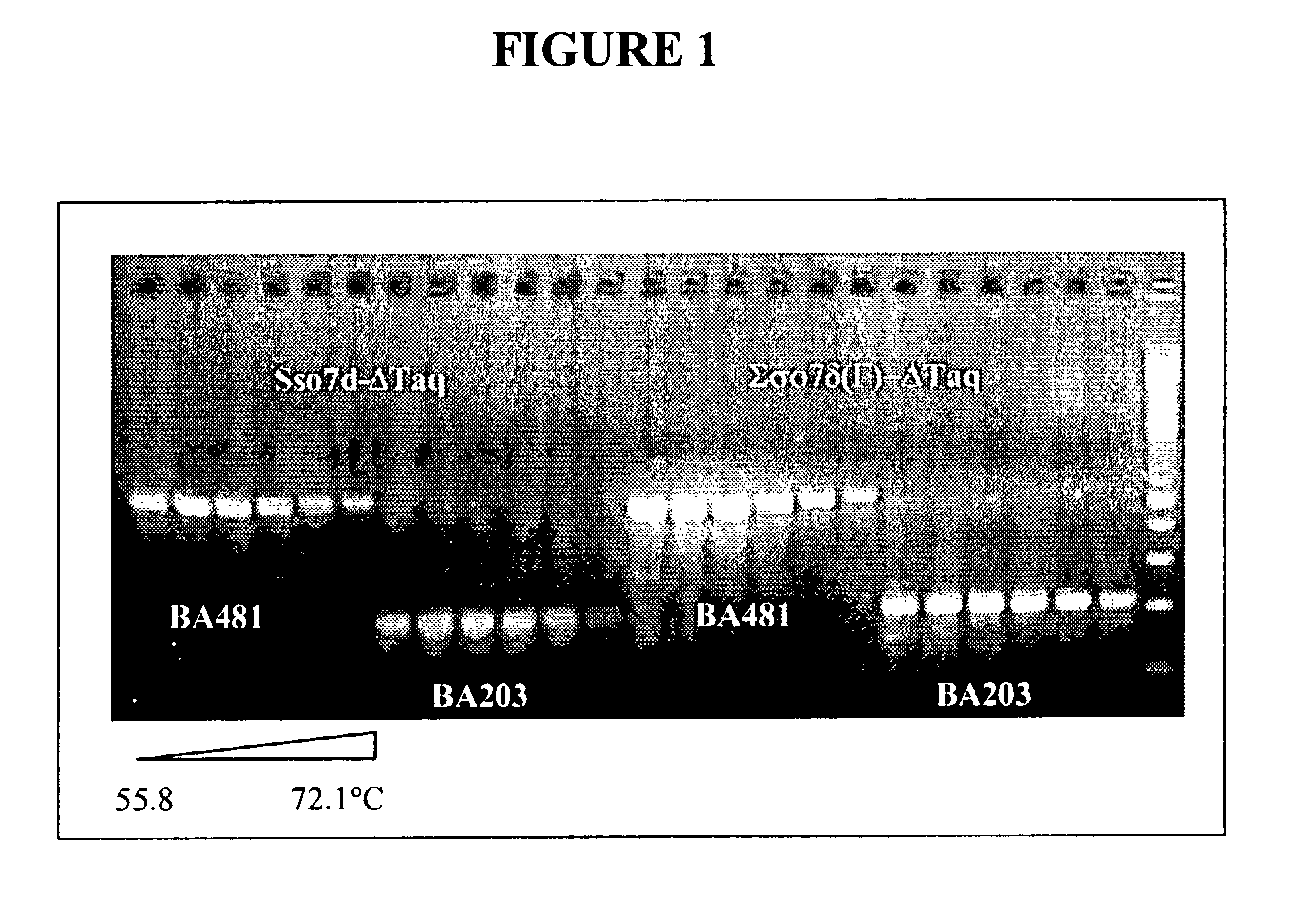Sso7-polymerase conjugate proteins
a polymerase and conjugate technology, applied in the direction of peptides, peptides/protein ingredients, transferases, etc., can solve the problems of reducing the discrimination between mismatched primers/templates and properly matched primers/templates, and the yield of low
- Summary
- Abstract
- Description
- Claims
- Application Information
AI Technical Summary
Benefits of technology
Problems solved by technology
Method used
Image
Examples
example 1
Construction of Mutant Sso7-ΔTaq Fusions
[0122]Sequential PCR was used to introduce the point mutations at the codon encoding W24 in the wild type Sso7d-ΔTaq set forth in SEQ ID NO:2. In the first round of PCR, primer pair M13R (5′ GCGGATAACAATTTCACACAGG 3′; SEQ ID NO:19) and W24T (5′ ATCTCCAAGATCAAGAAAGTAGNGCGTGTGGGCAAGATG 3′; SEQ ID NO:20), and primers pair W24AEVG-B (5′ CTACTTTCTTGATCTTGGAGAT 3′; SEQ ID NO:21) and 1008R (5′ GAGGGCTTTATAAGGCTCG 3′; SEQ ID NO:22) were used to amplify the corresponding regions from pYW1 (see, PCT publication WO 01 / 92501). The products from the first PCR were purified and combined together with primers M13R and 1008R in a second round of PCR to produce a 400 bp fragment. This fragment was digested with restriction enzymes EcoRI and BstXI and inserted into the corresponding site of pYW1. Primer W24-T contains a degenerate nucleotide at position 23 from the 5′ end, so that the final oligonucleotide will be a mixed population containing 25% each of G, T,...
example 2
Mismatch Primer Assay
[0123]Based on structural studies (Gao et al., Nature Struct. Biol. 5:782-786, 1998), the W24 residue in wildtype Sso7d is involved in anchoring a base in its unstacked position. This example shows that mutation at this position results in an increase in the primer-template binding specificity of the fusion protein.
[0124]Two pairs of primers were used to assess the ability of a PCR enzyme in discriminating matched primers and mismatched primers. The matched primer, 57F (5′ TCCGTTCTTCTTCGTCATAACT 3′; SEQ ID NO:23), is fully complementary to lambda DNA. The mismatched primer, 57F5 / 6 (5′ TCCGCCCTTCTTCGTCATAACT 3′; SEQ ID NO:24), contains two bases (position 5 and 6 from the 5′ end) that are not complementary to lambda DNA template. The same matched reverse primer, 732R (5′ CCTGACTGTTCGATATATTCACTC 3′; SEQ ID NO:25), is used with 57F or 57F516 to produce a 675 bp amplicon. The cycling program used was: 94° C.-1 mm 20×(94° C.-10 s, 50-74° C.-30 s, 72° C.-1 mm), 72° C...
example 3
Processivity Comparison of Wild-Type and Mutant Fusion Proteins
[0127]As the binding interaction between Sso7d and dsDNA is important to the enhancement of processivity of the fusion protein, the mutations introduced may abolish the enhancement. The processivity assay (see, PCT publication WO 01 / 92501) was used to measure the processivity of fusion proteins containing mutations at residue W24 of Sso7d, and the results are summarized in Table 2. Two of the three mutant proteins, W24G and W24V, still maintained a 2-fold higher processivity than the unmodified protein, ΔTaq. The mutant protein containing the W24E change exhibits the same processivity as the unmodified protein. These results suggest that different mutations at this position could have differential effect on the processivity of the fusion protein.
[0128]
TABLE 2Processivity comparisonProcessivityEnzymes(in Median product length)ΔTaq 4-6 ntTaq13-18 ntSso7d-ΔTaq31-39 ntSso7d(G)-ΔTaq 8-10 ntSso7d(V)-ΔTaq 7-11 ntSso7d(E)-ΔTaq 4...
PUM
| Property | Measurement | Unit |
|---|---|---|
| Fraction | aaaaa | aaaaa |
| Fraction | aaaaa | aaaaa |
| Thermal stability | aaaaa | aaaaa |
Abstract
Description
Claims
Application Information
 Login to View More
Login to View More - R&D
- Intellectual Property
- Life Sciences
- Materials
- Tech Scout
- Unparalleled Data Quality
- Higher Quality Content
- 60% Fewer Hallucinations
Browse by: Latest US Patents, China's latest patents, Technical Efficacy Thesaurus, Application Domain, Technology Topic, Popular Technical Reports.
© 2025 PatSnap. All rights reserved.Legal|Privacy policy|Modern Slavery Act Transparency Statement|Sitemap|About US| Contact US: help@patsnap.com


